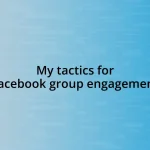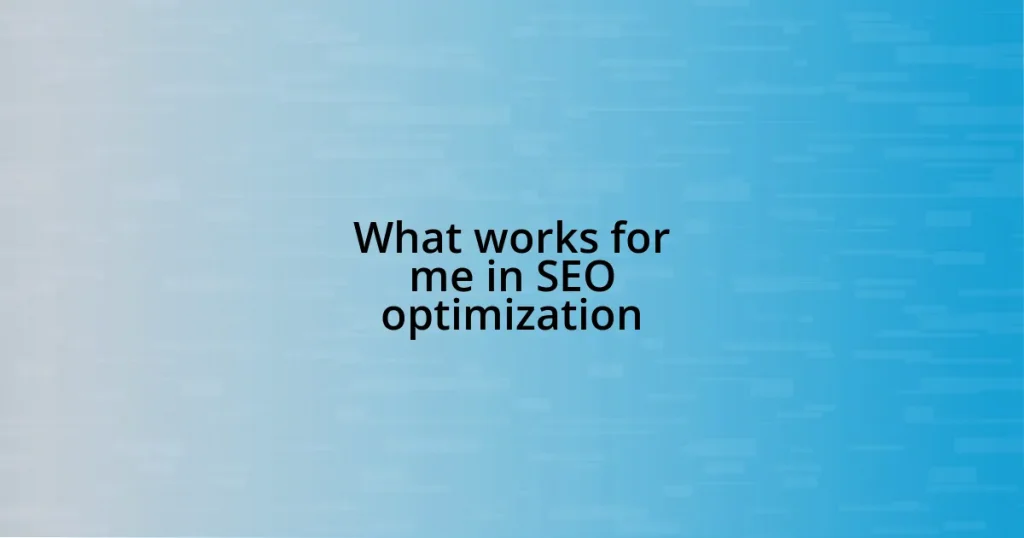Key takeaways:
- Understanding your personal brand involves defining your values and authenticity, which helps create genuine connections with others.
- Identifying your Unique Value Proposition (UVP) can enhance your brand by highlighting what sets you apart, including your experiences, skills, and personal story.
- Crafting a compelling brand story fosters a deeper connection with your audience, emphasizing personal journeys, challenges, and core values.
- Engaging with your audience through authentic interactions and feedback can refine your brand and build a supportive community around it.

Understanding Your Personal Brand
Understanding your personal brand goes beyond choosing a logo or a catchy tagline; it’s about defining what you stand for. I remember a time when I struggled to articulate my values and passions, which made it difficult for others to connect with me. Have you ever felt that disconnect? Establishing clarity about who you are can transform those relationships.
As I dove deeper into my brand journey, I realized that authenticity is key. One day, after a particularly honest conversation with a mentor about my fears and aspirations, I felt a weight lift off my shoulders. It dawned on me: my uniqueness stems from my experiences and vulnerabilities. Isn’t it liberating to embrace our imperfections?
Your personal brand also speaks volumes about how others perceive you. I was surprised to learn how people viewed me through their lenses, shaped by my online presence and interactions. It’s essential to understand this perception and actively shape it. What narrative do you want to create around your personal brand?

Identifying Your Unique Value Proposition
Identifying your Unique Value Proposition (UVP) is a transformative step in your branding journey. I remember sitting at my desk, pondering what really sets me apart from others in my field. It struck me that my UVP is a blend of my unique experiences, skills, and personal story. Isn’t it exciting to think that what makes you different can also be your greatest asset?
To further pinpoint my UVP, I reflected on the feedback I’d received from colleagues and clients. Their insights often highlighted qualities I didn’t initially recognize in myself, like my empathetic approach to problem-solving. It felt rewarding to understand how my kindness and relatability added value to my brand. How often do we overlook the strengths that come naturally to us?
As I continued this self-discovery process, I created a simple exercise: I wrote down what I wanted my audience to feel when they interacted with my brand. To my surprise, the qualities I penned—trust, inspiration, and support—aligned directly with my life’s passions. What a fulfilling realization! Knowing your UVP not only enhances your brand but also clarifies your path forward.
| Key Elements | Examples |
|---|---|
| Experience | Utilizing my background in marketing to connect authentically |
| Skills | Strong analytical skills paired with creative thinking |
| Personal Story | Overcoming challenges to build resilience |

Crafting Your Brand Story
Crafting a compelling brand story is like piecing together a beautiful mosaic that reflects your essence. I remember when I first shared my story at a networking event, feeling a mix of nervousness and excitement. As I spoke about my journey, I could see the engagement on people’s faces; it solidified the power of storytelling. Your brand story should resonate with your audience, creating a connection that goes beyond products and services.
Here are some key components to consider as you craft your own brand narrative:
- Personal Journey: Dive into your background, sharing experiences that shaped your values and passions.
- Challenges and Triumphs: Highlight obstacles you’ve overcome and the lessons learned, as these moments often resonate deeply with others.
- Core Values: Clearly define what you stand for, as this will help your audience relate to you on a personal level.
- Vision and Purpose: What do you hope to achieve with your brand? Articulating your goals can inspire and attract like-minded individuals.
- Emotional Connection: Use emotions to draw your audience in. Personal anecdotes can evoke empathy and intrigue, making your story memorable.
As I continue developing my brand, I find it essential to revisit my story regularly. Each step enriches not just my brand but my understanding of who I am at my core. It’s an ongoing journey of discovery, and I encourage you to embrace this process as well.

Building Your Online Presence
Building your online presence may seem daunting, but it’s a crucial aspect of branding that can significantly enhance visibility. I remember when I first established my social media accounts, feeling anxious about sharing my thoughts with the world. Each post became a small step toward authenticity, and I found that engaging with my audience allowed me to connect on a deeper level. Isn’t it amazing how building those connections can lead to unexpected opportunities?
To truly stand out online, I learned the importance of consistency—both in my messaging and my visual identity. Initially, I struggled with this, often posting pictures that didn’t reflect my brand. However, once I embraced a cohesive aesthetic, it was like a light bulb turned on. My online presence became more recognizable, and engagement levels soared. Have you ever considered how a unified look could enhance your brand’s credibility?
Another factor that’s shaped my online journey is authenticity. I’ve always believed in being genuine, sharing not just successes but also setbacks. When I posted about a project that hadn’t gone as planned, the response was overwhelming. People appreciated my vulnerability, which created a stronger bond with my audience. It taught me that being true to myself online invites others to do the same, fostering a supportive community. How can you inject authenticity into your own online presence?

Engaging with Your Audience
Engaging with your audience is one of the most rewarding elements of building a brand. I recall a moment when I hosted a live Q&A session on Instagram. The initial nerves quickly faded as I interacted with my followers in real-time. Each question they asked not only made me feel valued but also revealed insights into what truly interests them. This mutual exchange not only solidified my connection with my audience but also shaped how I approached my content moving forward. Isn’t it fascinating how a simple interaction can illuminate new facets of your brand?
Another aspect I cherish about audience engagement is the feedback loop it creates. I once launched a new product and eagerly awaited responses. The kinds words and constructive criticism offered by my followers played a pivotal role in refining my offerings. They felt a sense of ownership in what I was creating! Have you ever considered how valuable your audience’s opinions can be in shaping your brand? It turns out, their voices can guide you toward greater authenticity and relevance.
Lastly, I emphasize the importance of community-building through engaging content. I remember organizing a monthly challenge for my followers—something simple yet powerful. Each participant shared their experiences, and we created a space where everyone felt supported. Witnessing the connections formed among participants was truly heartwarming. It reminded me that, at its core, my brand is not just about showcasing products; it’s about nurturing relationships. How can you encourage community engagement in your own journey?

Measuring Your Brand Growth
When it comes to measuring brand growth, I find that analytics play a crucial role. For instance, I remember when I first dove into social media insights—I was amazed at how metrics like engagement rates and follower growth provided a clear picture of my brand’s evolution. Delving into these numbers didn’t just feel like homework; it sparked curiosity about what strategies truly resonated with my audience. Have you ever looked closely at your analytics to uncover trends you hadn’t noticed before?
Another essential measurement I’ve embraced is monitoring audience sentiment. I often check comments and messages to gauge how my brand is perceived, and this has led to some eye-opening moments. One time, a follower shared how my content inspired them during a tough period. That affirmation fueled my motivation and helped me understand the emotional impact my brand can have. How do you capture the feelings your audience associates with your brand?
Lastly, I’ve started to track collaboration opportunities as a metric of growth. When I began reaching out to other creators, I noticed an uptick in my network and visibility. A memorable collaboration was with a fellow creator where we exchanged ideas and learned from each other’s experiences. That not only expanded my audience but also deepened my understanding of my own brand identity. It’s incredible to see how relationships can serve as vital indicators of growth. What collaborations have you considered that could elevate your brand’s journey?















